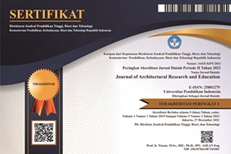The Effect of Opening Design On Natural Ventilation In Classrooms of Elementary School 02 Ciputat
Abstract
Abstract - Schools are facilities to meet educational needs and will continue to develop over time. Based on the Basic Education Data from the Ministry of Education and Culture of South Tangerang City, the number of elementary schools in the city is 344. Thermal comfort in the classroom will affect students' learning effectiveness. One of the factors that affects the effectiveness of a room is the suitability of openings in the building for natural ventilation. Poor ventilation will result in suboptimal air circulation in the classroom, which will affect students' concentration during the learning process in the classroom. This study aims to determine the effectiveness of natural ventilation using air opening calculations in a room, specifically the classroom of SDN 02 Ciputat. The results of these calculations will be analyzed and reviewed further, and adjusted to meet the standard values set by SNI 03-6572-2001. The results of the initial design calculations do not meet the standards, so an alternative design that meets the standards is required. The alternative design that was analyzed sufficiently meets the standards with an Inlet Efficiency value of 19.6% and an Outlet Efficiency of 5.9%. This research is expected to provide useful guidelines in constructing more comfortable and efficient elementary school classrooms for building users.
keywords – Natural Ventilation, Opening Design, Air Opening Calculation.
Keywords
Full Text:
PDFReferences
Boutet, T.S. (1987) Controlling Air Movement: A Manual for Architects and Builders. McGraw Hill Book Company, New York.
Laela, N. L. (2013). Fisika Bangunan I. Jakarta: Griya Kreasi.
Law, A.M. and Kelton, W.D. (1991) Simulation Modelling and Analysis. 2nd Edition, McGraw-Hill, New York.
Lee, S. C., & M.Chang. (2000). Indoor and Outdoor Air Quality Investigation at Schools in Hong Kong. PERGAMON Journal, Chemosphere.
Liddament, M. A. (1996). Guide to Energy Efficient Ventilation. Air Infiltration and Ventilation Centre, Coventry.
Melita, A. H., Adhitama, M. S., & Nugroho, A. M. (2017). Pengaruh Bukaan Terhadap Kenyamanan Suhu Pada Masjid Jakarta Islamic Center. Jurnal Mahasiswa Jurusan Arsitektur Universitas Brawijaya.
Neufert, E. (1993). Data Arsitek : jilid 2. Jakarta : Penerbit Erlangga.
Sangkertadi, F. R. (1999). Pembuatan program simulasi penghawaan alami Ventila.1.0 untuk pengembangan praktikum pada mahasiswa Arsitektur S-1.
Satwiko, & Prasasto. (2003). Fisika Bangunan 1. Yogyakarta: Penerbit Andi.
Dep. Pekerjaan Umum. (2001). Tata Cara Perancangan Sistem Ventilasi dan Pengkondisian Udara pada Bangunan Gedung. In Sni 03 - 6572 - 2001. SNI 03-6572-2001
Sudiarta, I. N. (2016). Penghawaan Alami. Faculty of Law Arts and Social Sciences. School of education. Universitas Udayana; Indonesia.
Sugini, D. (2014). Penerapan Thermal Pada Ruang. In Kenyamanan Thermal Ruang (p. 254). Yogyakarta: Graha Ilmu.
Wheater Spark. (2024). Rata-rata Kecepatan Angin di Tangerang Selatan.
Widyanto, H. B. (2018). Sistem Monitoring Kecepatan dan Arah Angin Berbasis Internet of Thing (IOT) Sebagai Peringatan Dini Bencana Alam. Skripsi. Fakultas Teknik. Teknik Elektro. Universitas Brawijaya: Malang.
DOI: https://doi.org/10.17509/jare.v7i1.79033
Refbacks
- There are currently no refbacks.
Copyright (c) 2025 Journal of Architectural Research and Education

This work is licensed under a Creative Commons Attribution-NonCommercial-ShareAlike 4.0 International License.

This work is licensed under a Creative Commons Attribution-ShareAlike 4.0 International License.








